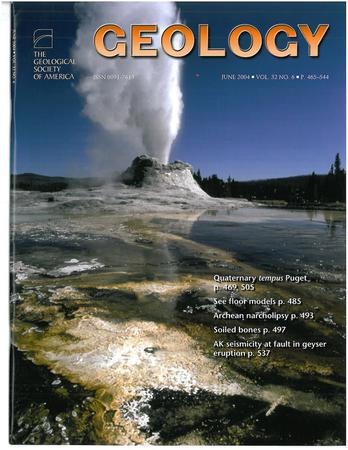Icy thermometers: Quantifying the impact of volcanic heat on glacier elevation
IF 4.8
1区 地球科学
Q1 GEOLOGY
引用次数: 0
Abstract
We present a continentwide study of 600 glaciers located on and near 37 ice-clad volcanoes in South America. Results demonstrate glacier sensitivity to volcanic heat. We distinguished between “volcanic glaciers” (≤1 km from volcanic centers; n = 74), and “proximal glaciers” (1−15 km; n = 526) and calculated their equilibrium line altitudes (ELAs). For each ice-clad volcano, we compared the ELAs of its volcanic glaciers to those of its proximal glaciers, which showed that the ELAs of the former are higher than the ELAs of the latter. ∆ELAmean, defined as the offset between the mean ELA of the volcanic glaciers compared with that of the proximal glaciers, was calculated for each ice-clad volcano. ∆ELAmean was positive for 92% of the 37 volcanoes, and a quantitative relationship between ΔELAmean and volcanic thermal anomaly was established. Results highlight the impact of volcanic heat on glacier elevation; emphasize the need to exclude glaciers on, or near, volcanoes from glacier-climate investigations; and demonstrate the first-order potential for glaciers as “volcanic thermometers.” Volcanic-glacier monitoring could contribute to our understanding of magmatic and thermal activity, with changes in glacier geometries potentially reflecting long-term fluctuations in volcanic heat and unrest.冰冻温度计:量化火山热对冰川高度的影响
我们对位于南美洲37座覆冰火山及其附近的600座冰川进行了全大陆范围的研究。结果表明冰川对火山热的敏感性。我们区分了“火山冰川”(距离火山中心≤1公里;n=74)和“近端冰川”(1−15公里;n=526),并计算了它们的平衡线高度(ELAs)。对于每一座覆冰火山,我们将其火山冰川的ELA与其近端冰川的ELAs进行了比较,结果表明前者的ELA高于后者的ELA。∆ELMean,定义为火山冰川的平均ELA与近端冰川的平均EL之间的偏移,是为每个覆冰火山计算的。∆在37座火山中,92%的ELAmin为正,ΔELAmin与火山热异常之间建立了定量关系。结果突出了火山热对冰川高程的影响;强调必须将火山上或火山附近的冰川排除在冰川气候调查之外;并证明了冰川作为“火山温度计”的一阶潜力。火山冰川监测可能有助于我们理解岩浆和热活动,冰川几何形状的变化可能反映出火山热和动荡的长期波动。
本文章由计算机程序翻译,如有差异,请以英文原文为准。
求助全文
约1分钟内获得全文
求助全文
来源期刊

Geology
地学-地质学
CiteScore
10.00
自引率
3.40%
发文量
228
审稿时长
6.2 months
期刊介绍:
Published since 1973, Geology features rapid publication of about 23 refereed short (four-page) papers each month. Articles cover all earth-science disciplines and include new investigations and provocative topics. Professional geologists and university-level students in the earth sciences use this widely read journal to keep up with scientific research trends. The online forum section facilitates author-reader dialog. Includes color and occasional large-format illustrations on oversized loose inserts.
 求助内容:
求助内容: 应助结果提醒方式:
应助结果提醒方式:


